Analyzing Information and Technology Management at Tesco: Report
VerifiedAdded on 2019/12/28
|9
|2973
|154
Report
AI Summary
This report examines the information technology management practices of Tesco, a leading British multinational retail company. It begins with an introduction to IT management and its importance for businesses, particularly in cost reduction and customer responsiveness. The report then delves into Tesco's macro environment, analyzing political, economic, social, technological, legal, and environmental factors influencing its operations. It further explores Tesco's use of Porter's value chain, focusing on primary activities such as inbound logistics, operations, outbound logistics, marketing and sales, and service to identify areas for competitive advantage. The report highlights how Tesco leverages IT techniques, including research and development, digital platforms, and social media, to enhance its brand value, improve customer engagement, and achieve cost leadership. Finally, it emphasizes the importance of adapting to technological changes and addressing environmental concerns through innovative solutions like carbon dioxide reduction and real-time translation tools to support global expansion and customer communication.
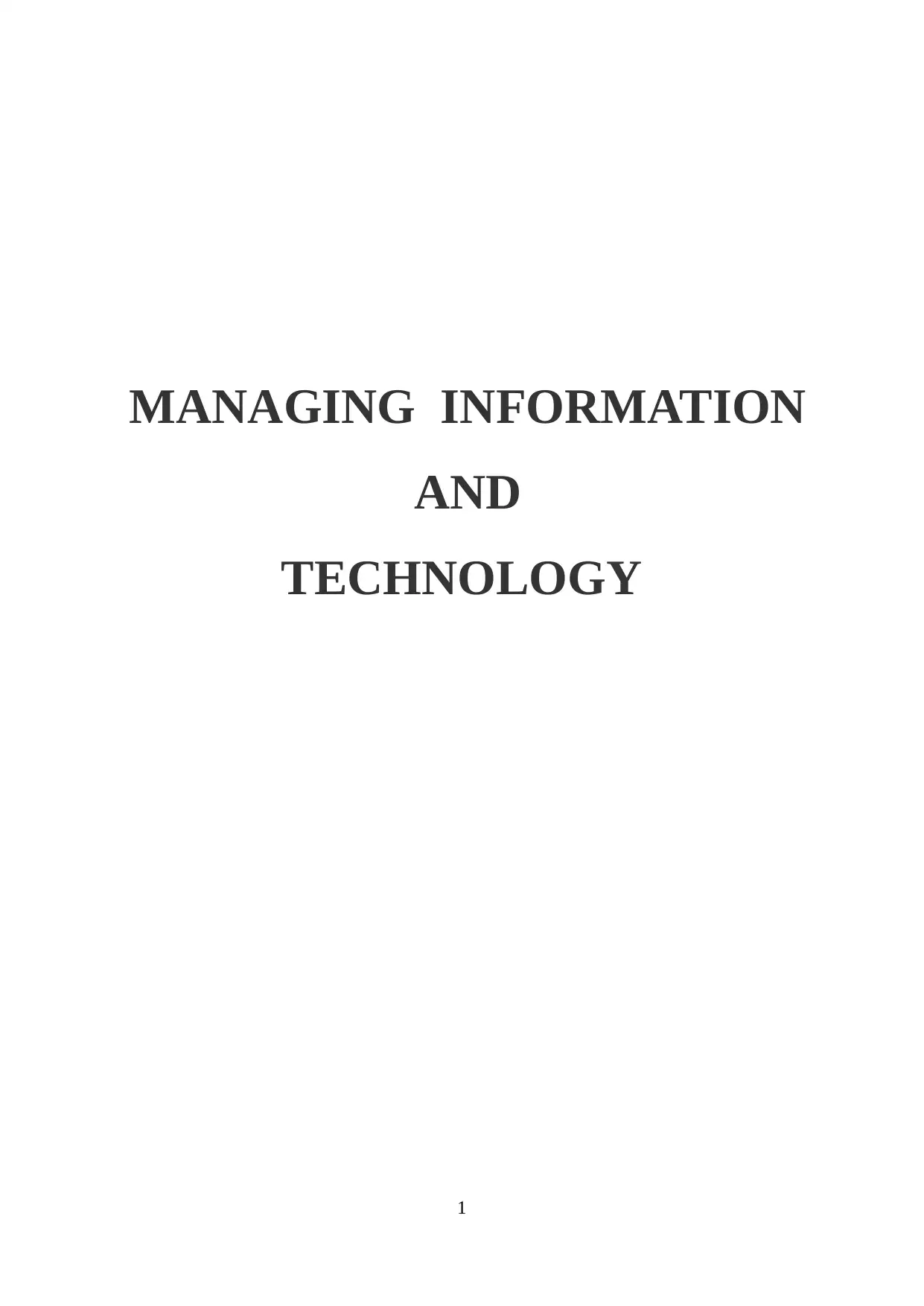
MANAGING INFORMATION
AND
TECHNOLOGY
1
AND
TECHNOLOGY
1
Paraphrase This Document
Need a fresh take? Get an instant paraphrase of this document with our AI Paraphraser
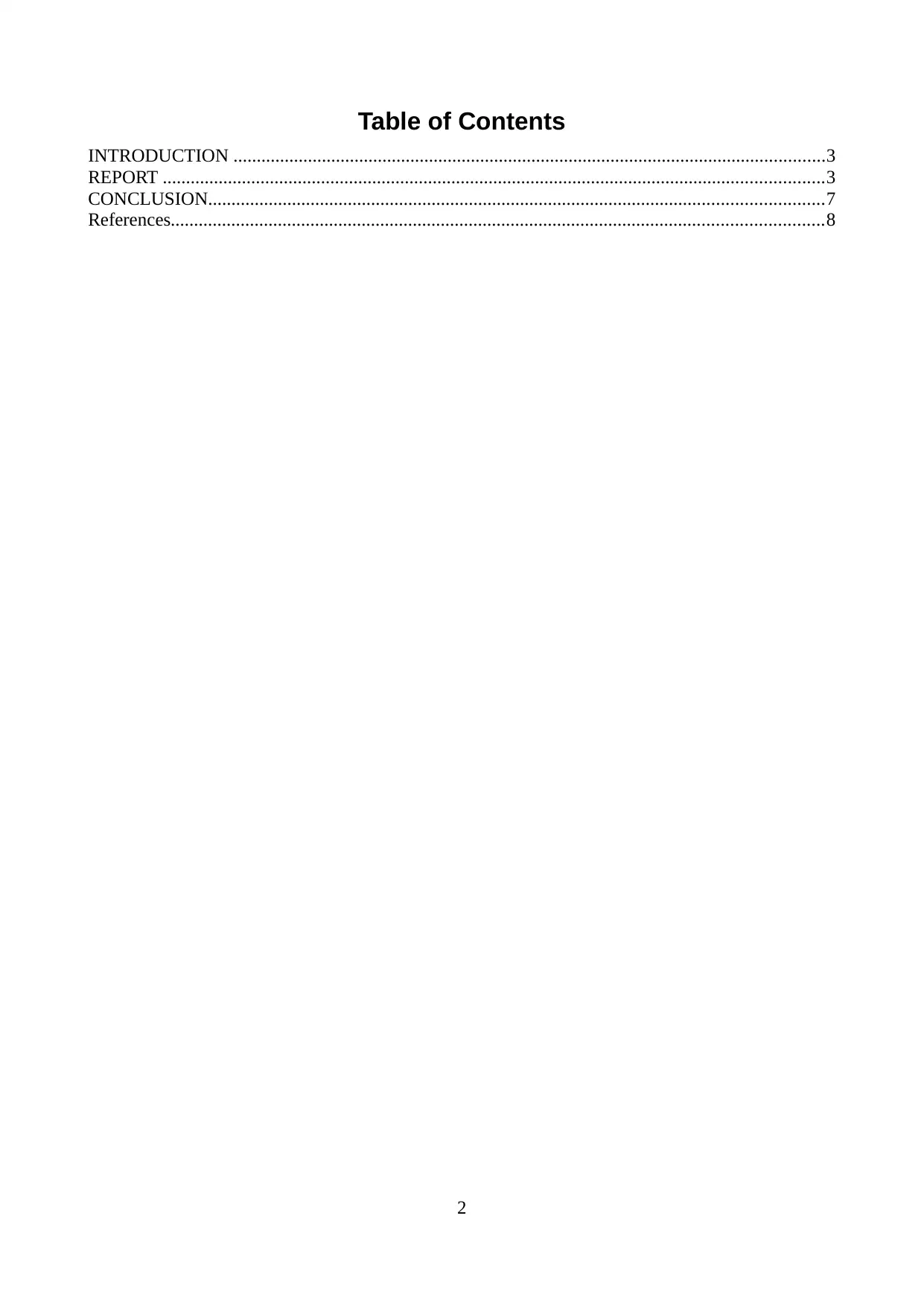
Table of Contents
INTRODUCTION ...............................................................................................................................3
REPORT ..............................................................................................................................................3
CONCLUSION....................................................................................................................................7
References............................................................................................................................................8
2
INTRODUCTION ...............................................................................................................................3
REPORT ..............................................................................................................................................3
CONCLUSION....................................................................................................................................7
References............................................................................................................................................8
2
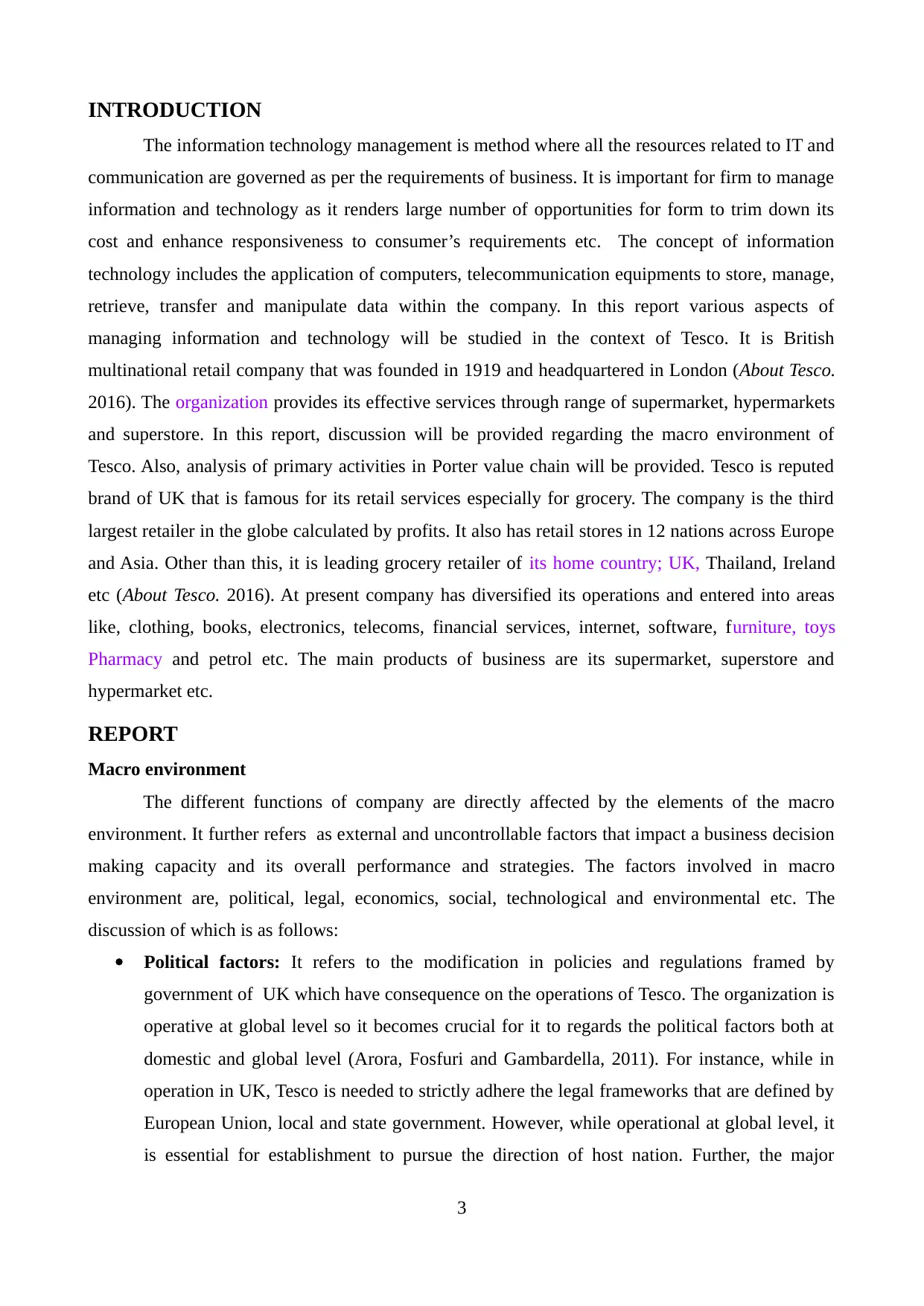
INTRODUCTION
The information technology management is method where all the resources related to IT and
communication are governed as per the requirements of business. It is important for firm to manage
information and technology as it renders large number of opportunities for form to trim down its
cost and enhance responsiveness to consumer’s requirements etc. The concept of information
technology includes the application of computers, telecommunication equipments to store, manage,
retrieve, transfer and manipulate data within the company. In this report various aspects of
managing information and technology will be studied in the context of Tesco. It is British
multinational retail company that was founded in 1919 and headquartered in London (About Tesco.
2016). The organization provides its effective services through range of supermarket, hypermarkets
and superstore. In this report, discussion will be provided regarding the macro environment of
Tesco. Also, analysis of primary activities in Porter value chain will be provided. Tesco is reputed
brand of UK that is famous for its retail services especially for grocery. The company is the third
largest retailer in the globe calculated by profits. It also has retail stores in 12 nations across Europe
and Asia. Other than this, it is leading grocery retailer of its home country; UK, Thailand, Ireland
etc (About Tesco. 2016). At present company has diversified its operations and entered into areas
like, clothing, books, electronics, telecoms, financial services, internet, software, furniture, toys
Pharmacy and petrol etc. The main products of business are its supermarket, superstore and
hypermarket etc.
REPORT
Macro environment
The different functions of company are directly affected by the elements of the macro
environment. It further refers as external and uncontrollable factors that impact a business decision
making capacity and its overall performance and strategies. The factors involved in macro
environment are, political, legal, economics, social, technological and environmental etc. The
discussion of which is as follows:
Political factors: It refers to the modification in policies and regulations framed by
government of UK which have consequence on the operations of Tesco. The organization is
operative at global level so it becomes crucial for it to regards the political factors both at
domestic and global level (Arora, Fosfuri and Gambardella, 2011). For instance, while in
operation in UK, Tesco is needed to strictly adhere the legal frameworks that are defined by
European Union, local and state government. However, while operational at global level, it
is essential for establishment to pursue the direction of host nation. Further, the major
3
The information technology management is method where all the resources related to IT and
communication are governed as per the requirements of business. It is important for firm to manage
information and technology as it renders large number of opportunities for form to trim down its
cost and enhance responsiveness to consumer’s requirements etc. The concept of information
technology includes the application of computers, telecommunication equipments to store, manage,
retrieve, transfer and manipulate data within the company. In this report various aspects of
managing information and technology will be studied in the context of Tesco. It is British
multinational retail company that was founded in 1919 and headquartered in London (About Tesco.
2016). The organization provides its effective services through range of supermarket, hypermarkets
and superstore. In this report, discussion will be provided regarding the macro environment of
Tesco. Also, analysis of primary activities in Porter value chain will be provided. Tesco is reputed
brand of UK that is famous for its retail services especially for grocery. The company is the third
largest retailer in the globe calculated by profits. It also has retail stores in 12 nations across Europe
and Asia. Other than this, it is leading grocery retailer of its home country; UK, Thailand, Ireland
etc (About Tesco. 2016). At present company has diversified its operations and entered into areas
like, clothing, books, electronics, telecoms, financial services, internet, software, furniture, toys
Pharmacy and petrol etc. The main products of business are its supermarket, superstore and
hypermarket etc.
REPORT
Macro environment
The different functions of company are directly affected by the elements of the macro
environment. It further refers as external and uncontrollable factors that impact a business decision
making capacity and its overall performance and strategies. The factors involved in macro
environment are, political, legal, economics, social, technological and environmental etc. The
discussion of which is as follows:
Political factors: It refers to the modification in policies and regulations framed by
government of UK which have consequence on the operations of Tesco. The organization is
operative at global level so it becomes crucial for it to regards the political factors both at
domestic and global level (Arora, Fosfuri and Gambardella, 2011). For instance, while in
operation in UK, Tesco is needed to strictly adhere the legal frameworks that are defined by
European Union, local and state government. However, while operational at global level, it
is essential for establishment to pursue the direction of host nation. Further, the major
3
⊘ This is a preview!⊘
Do you want full access?
Subscribe today to unlock all pages.

Trusted by 1+ million students worldwide
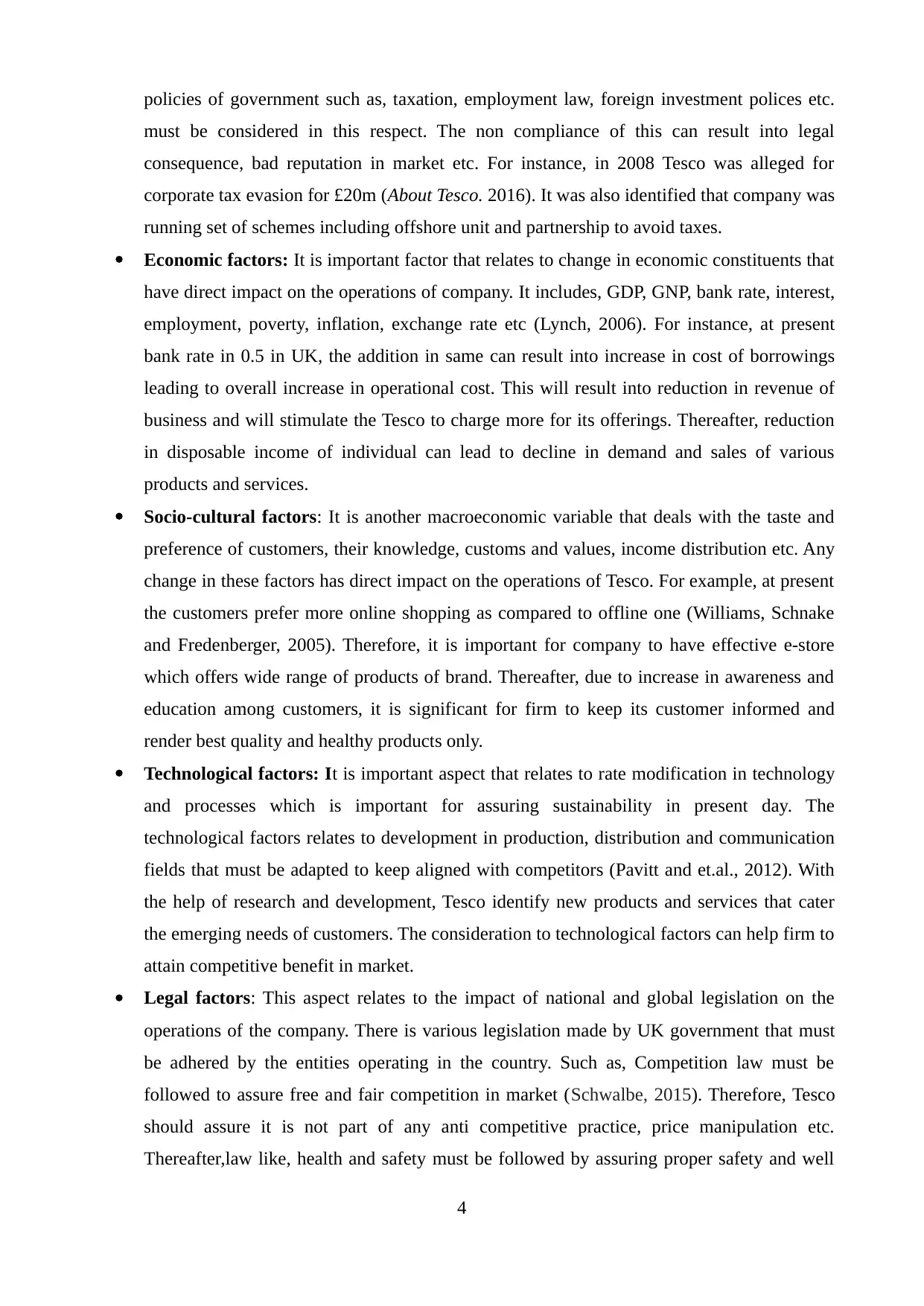
policies of government such as, taxation, employment law, foreign investment polices etc.
must be considered in this respect. The non compliance of this can result into legal
consequence, bad reputation in market etc. For instance, in 2008 Tesco was alleged for
corporate tax evasion for £20m (About Tesco. 2016). It was also identified that company was
running set of schemes including offshore unit and partnership to avoid taxes.
Economic factors: It is important factor that relates to change in economic constituents that
have direct impact on the operations of company. It includes, GDP, GNP, bank rate, interest,
employment, poverty, inflation, exchange rate etc (Lynch, 2006). For instance, at present
bank rate in 0.5 in UK, the addition in same can result into increase in cost of borrowings
leading to overall increase in operational cost. This will result into reduction in revenue of
business and will stimulate the Tesco to charge more for its offerings. Thereafter, reduction
in disposable income of individual can lead to decline in demand and sales of various
products and services.
Socio-cultural factors: It is another macroeconomic variable that deals with the taste and
preference of customers, their knowledge, customs and values, income distribution etc. Any
change in these factors has direct impact on the operations of Tesco. For example, at present
the customers prefer more online shopping as compared to offline one (Williams, Schnake
and Fredenberger, 2005). Therefore, it is important for company to have effective e-store
which offers wide range of products of brand. Thereafter, due to increase in awareness and
education among customers, it is significant for firm to keep its customer informed and
render best quality and healthy products only.
Technological factors: It is important aspect that relates to rate modification in technology
and processes which is important for assuring sustainability in present day. The
technological factors relates to development in production, distribution and communication
fields that must be adapted to keep aligned with competitors (Pavitt and et.al., 2012). With
the help of research and development, Tesco identify new products and services that cater
the emerging needs of customers. The consideration to technological factors can help firm to
attain competitive benefit in market.
Legal factors: This aspect relates to the impact of national and global legislation on the
operations of the company. There is various legislation made by UK government that must
be adhered by the entities operating in the country. Such as, Competition law must be
followed to assure free and fair competition in market (Schwalbe, 2015). Therefore, Tesco
should assure it is not part of any anti competitive practice, price manipulation etc.
Thereafter,law like, health and safety must be followed by assuring proper safety and well
4
must be considered in this respect. The non compliance of this can result into legal
consequence, bad reputation in market etc. For instance, in 2008 Tesco was alleged for
corporate tax evasion for £20m (About Tesco. 2016). It was also identified that company was
running set of schemes including offshore unit and partnership to avoid taxes.
Economic factors: It is important factor that relates to change in economic constituents that
have direct impact on the operations of company. It includes, GDP, GNP, bank rate, interest,
employment, poverty, inflation, exchange rate etc (Lynch, 2006). For instance, at present
bank rate in 0.5 in UK, the addition in same can result into increase in cost of borrowings
leading to overall increase in operational cost. This will result into reduction in revenue of
business and will stimulate the Tesco to charge more for its offerings. Thereafter, reduction
in disposable income of individual can lead to decline in demand and sales of various
products and services.
Socio-cultural factors: It is another macroeconomic variable that deals with the taste and
preference of customers, their knowledge, customs and values, income distribution etc. Any
change in these factors has direct impact on the operations of Tesco. For example, at present
the customers prefer more online shopping as compared to offline one (Williams, Schnake
and Fredenberger, 2005). Therefore, it is important for company to have effective e-store
which offers wide range of products of brand. Thereafter, due to increase in awareness and
education among customers, it is significant for firm to keep its customer informed and
render best quality and healthy products only.
Technological factors: It is important aspect that relates to rate modification in technology
and processes which is important for assuring sustainability in present day. The
technological factors relates to development in production, distribution and communication
fields that must be adapted to keep aligned with competitors (Pavitt and et.al., 2012). With
the help of research and development, Tesco identify new products and services that cater
the emerging needs of customers. The consideration to technological factors can help firm to
attain competitive benefit in market.
Legal factors: This aspect relates to the impact of national and global legislation on the
operations of the company. There is various legislation made by UK government that must
be adhered by the entities operating in the country. Such as, Competition law must be
followed to assure free and fair competition in market (Schwalbe, 2015). Therefore, Tesco
should assure it is not part of any anti competitive practice, price manipulation etc.
Thereafter,law like, health and safety must be followed by assuring proper safety and well
4
Paraphrase This Document
Need a fresh take? Get an instant paraphrase of this document with our AI Paraphraser
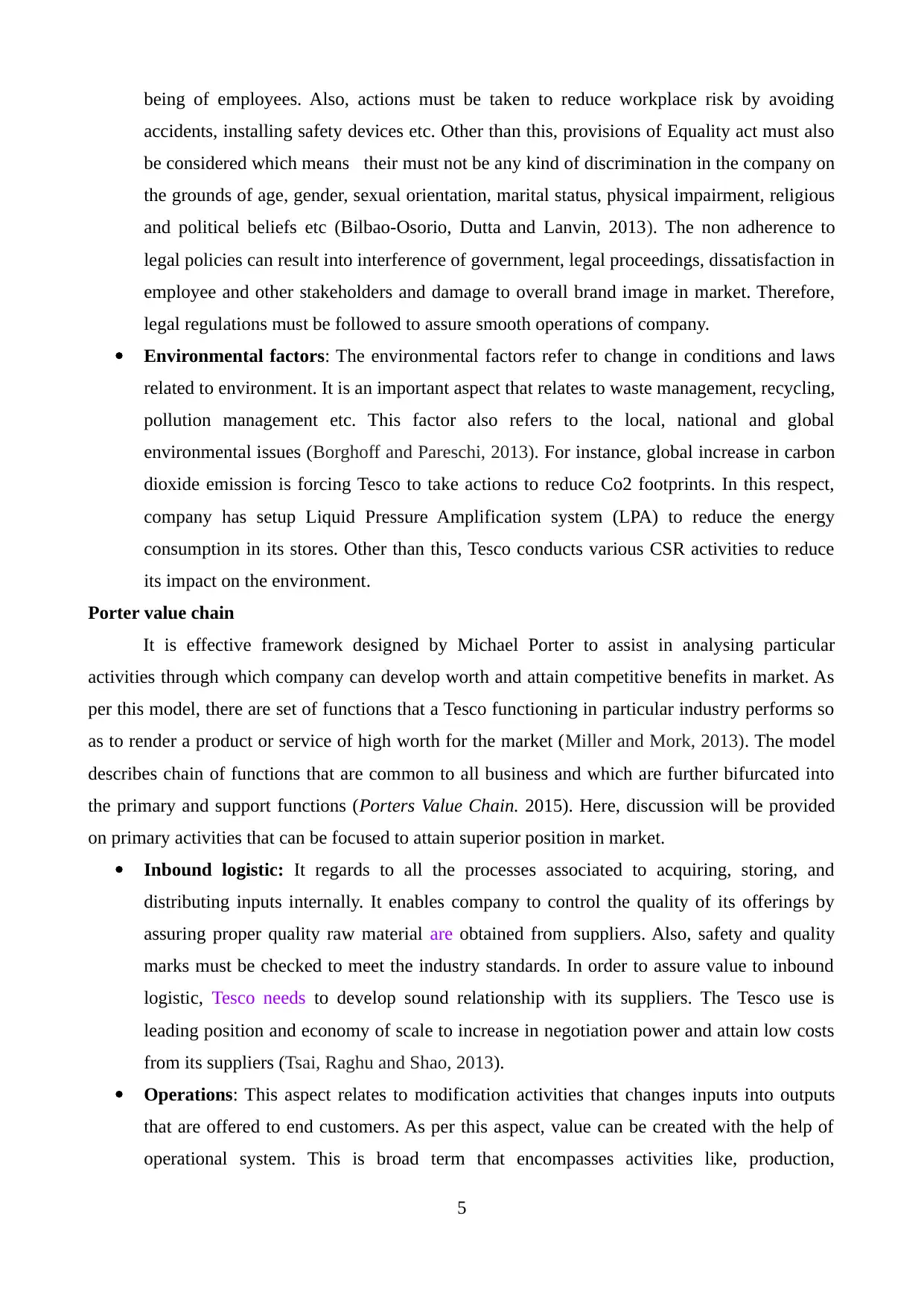
being of employees. Also, actions must be taken to reduce workplace risk by avoiding
accidents, installing safety devices etc. Other than this, provisions of Equality act must also
be considered which means their must not be any kind of discrimination in the company on
the grounds of age, gender, sexual orientation, marital status, physical impairment, religious
and political beliefs etc (Bilbao-Osorio, Dutta and Lanvin, 2013). The non adherence to
legal policies can result into interference of government, legal proceedings, dissatisfaction in
employee and other stakeholders and damage to overall brand image in market. Therefore,
legal regulations must be followed to assure smooth operations of company.
Environmental factors: The environmental factors refer to change in conditions and laws
related to environment. It is an important aspect that relates to waste management, recycling,
pollution management etc. This factor also refers to the local, national and global
environmental issues (Borghoff and Pareschi, 2013). For instance, global increase in carbon
dioxide emission is forcing Tesco to take actions to reduce Co2 footprints. In this respect,
company has setup Liquid Pressure Amplification system (LPA) to reduce the energy
consumption in its stores. Other than this, Tesco conducts various CSR activities to reduce
its impact on the environment.
Porter value chain
It is effective framework designed by Michael Porter to assist in analysing particular
activities through which company can develop worth and attain competitive benefits in market. As
per this model, there are set of functions that a Tesco functioning in particular industry performs so
as to render a product or service of high worth for the market (Miller and Mork, 2013). The model
describes chain of functions that are common to all business and which are further bifurcated into
the primary and support functions (Porters Value Chain. 2015). Here, discussion will be provided
on primary activities that can be focused to attain superior position in market.
Inbound logistic: It regards to all the processes associated to acquiring, storing, and
distributing inputs internally. It enables company to control the quality of its offerings by
assuring proper quality raw material are obtained from suppliers. Also, safety and quality
marks must be checked to meet the industry standards. In order to assure value to inbound
logistic, Tesco needs to develop sound relationship with its suppliers. The Tesco use is
leading position and economy of scale to increase in negotiation power and attain low costs
from its suppliers (Tsai, Raghu and Shao, 2013).
Operations: This aspect relates to modification activities that changes inputs into outputs
that are offered to end customers. As per this aspect, value can be created with the help of
operational system. This is broad term that encompasses activities like, production,
5
accidents, installing safety devices etc. Other than this, provisions of Equality act must also
be considered which means their must not be any kind of discrimination in the company on
the grounds of age, gender, sexual orientation, marital status, physical impairment, religious
and political beliefs etc (Bilbao-Osorio, Dutta and Lanvin, 2013). The non adherence to
legal policies can result into interference of government, legal proceedings, dissatisfaction in
employee and other stakeholders and damage to overall brand image in market. Therefore,
legal regulations must be followed to assure smooth operations of company.
Environmental factors: The environmental factors refer to change in conditions and laws
related to environment. It is an important aspect that relates to waste management, recycling,
pollution management etc. This factor also refers to the local, national and global
environmental issues (Borghoff and Pareschi, 2013). For instance, global increase in carbon
dioxide emission is forcing Tesco to take actions to reduce Co2 footprints. In this respect,
company has setup Liquid Pressure Amplification system (LPA) to reduce the energy
consumption in its stores. Other than this, Tesco conducts various CSR activities to reduce
its impact on the environment.
Porter value chain
It is effective framework designed by Michael Porter to assist in analysing particular
activities through which company can develop worth and attain competitive benefits in market. As
per this model, there are set of functions that a Tesco functioning in particular industry performs so
as to render a product or service of high worth for the market (Miller and Mork, 2013). The model
describes chain of functions that are common to all business and which are further bifurcated into
the primary and support functions (Porters Value Chain. 2015). Here, discussion will be provided
on primary activities that can be focused to attain superior position in market.
Inbound logistic: It regards to all the processes associated to acquiring, storing, and
distributing inputs internally. It enables company to control the quality of its offerings by
assuring proper quality raw material are obtained from suppliers. Also, safety and quality
marks must be checked to meet the industry standards. In order to assure value to inbound
logistic, Tesco needs to develop sound relationship with its suppliers. The Tesco use is
leading position and economy of scale to increase in negotiation power and attain low costs
from its suppliers (Tsai, Raghu and Shao, 2013).
Operations: This aspect relates to modification activities that changes inputs into outputs
that are offered to end customers. As per this aspect, value can be created with the help of
operational system. This is broad term that encompasses activities like, production,
5
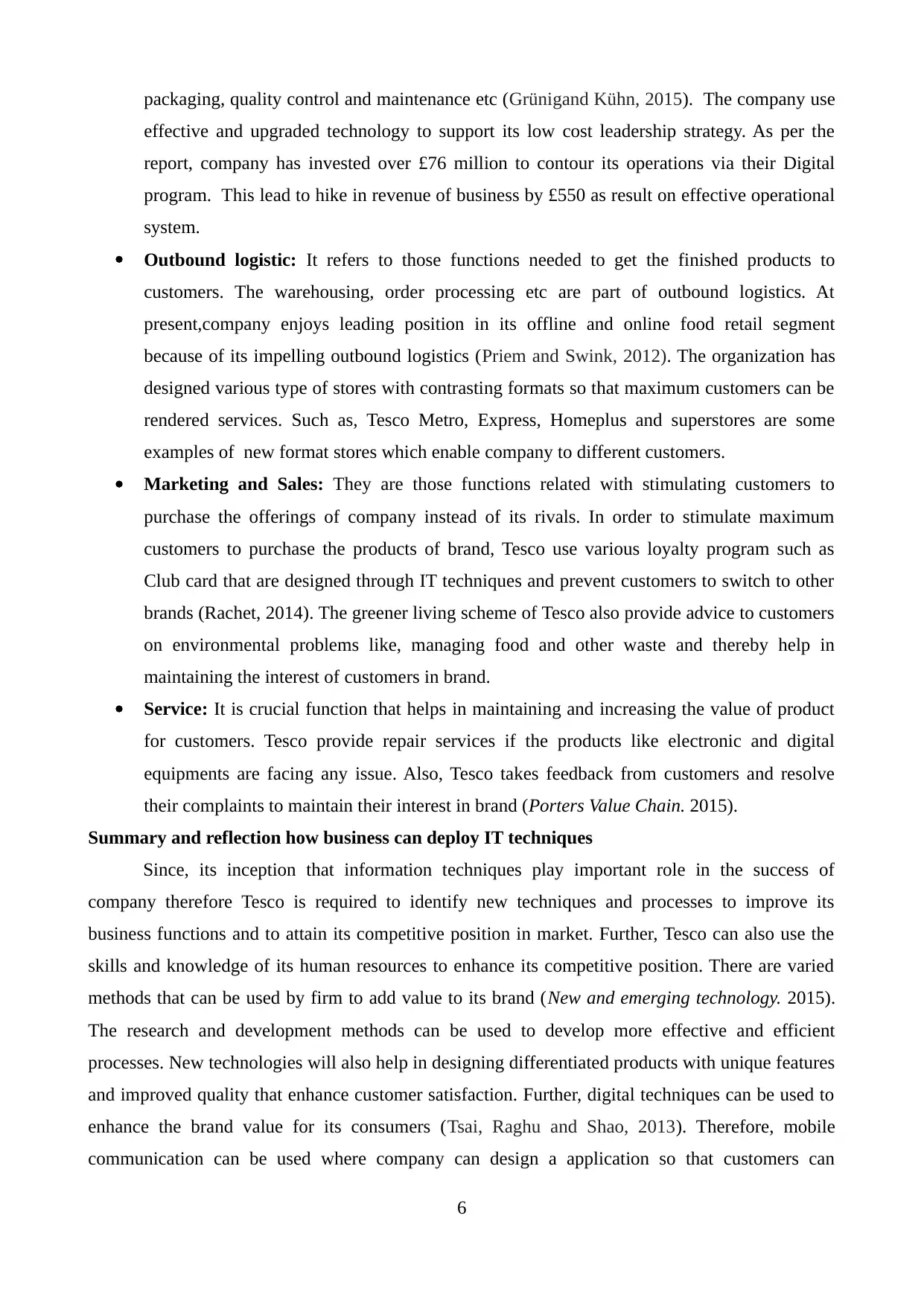
packaging, quality control and maintenance etc (Grünigand Kühn, 2015). The company use
effective and upgraded technology to support its low cost leadership strategy. As per the
report, company has invested over £76 million to contour its operations via their Digital
program. This lead to hike in revenue of business by £550 as result on effective operational
system.
Outbound logistic: It refers to those functions needed to get the finished products to
customers. The warehousing, order processing etc are part of outbound logistics. At
present,company enjoys leading position in its offline and online food retail segment
because of its impelling outbound logistics (Priem and Swink, 2012). The organization has
designed various type of stores with contrasting formats so that maximum customers can be
rendered services. Such as, Tesco Metro, Express, Homeplus and superstores are some
examples of new format stores which enable company to different customers.
Marketing and Sales: They are those functions related with stimulating customers to
purchase the offerings of company instead of its rivals. In order to stimulate maximum
customers to purchase the products of brand, Tesco use various loyalty program such as
Club card that are designed through IT techniques and prevent customers to switch to other
brands (Rachet, 2014). The greener living scheme of Tesco also provide advice to customers
on environmental problems like, managing food and other waste and thereby help in
maintaining the interest of customers in brand.
Service: It is crucial function that helps in maintaining and increasing the value of product
for customers. Tesco provide repair services if the products like electronic and digital
equipments are facing any issue. Also, Tesco takes feedback from customers and resolve
their complaints to maintain their interest in brand (Porters Value Chain. 2015).
Summary and reflection how business can deploy IT techniques
Since, its inception that information techniques play important role in the success of
company therefore Tesco is required to identify new techniques and processes to improve its
business functions and to attain its competitive position in market. Further, Tesco can also use the
skills and knowledge of its human resources to enhance its competitive position. There are varied
methods that can be used by firm to add value to its brand (New and emerging technology. 2015).
The research and development methods can be used to develop more effective and efficient
processes. New technologies will also help in designing differentiated products with unique features
and improved quality that enhance customer satisfaction. Further, digital techniques can be used to
enhance the brand value for its consumers (Tsai, Raghu and Shao, 2013). Therefore, mobile
communication can be used where company can design a application so that customers can
6
effective and upgraded technology to support its low cost leadership strategy. As per the
report, company has invested over £76 million to contour its operations via their Digital
program. This lead to hike in revenue of business by £550 as result on effective operational
system.
Outbound logistic: It refers to those functions needed to get the finished products to
customers. The warehousing, order processing etc are part of outbound logistics. At
present,company enjoys leading position in its offline and online food retail segment
because of its impelling outbound logistics (Priem and Swink, 2012). The organization has
designed various type of stores with contrasting formats so that maximum customers can be
rendered services. Such as, Tesco Metro, Express, Homeplus and superstores are some
examples of new format stores which enable company to different customers.
Marketing and Sales: They are those functions related with stimulating customers to
purchase the offerings of company instead of its rivals. In order to stimulate maximum
customers to purchase the products of brand, Tesco use various loyalty program such as
Club card that are designed through IT techniques and prevent customers to switch to other
brands (Rachet, 2014). The greener living scheme of Tesco also provide advice to customers
on environmental problems like, managing food and other waste and thereby help in
maintaining the interest of customers in brand.
Service: It is crucial function that helps in maintaining and increasing the value of product
for customers. Tesco provide repair services if the products like electronic and digital
equipments are facing any issue. Also, Tesco takes feedback from customers and resolve
their complaints to maintain their interest in brand (Porters Value Chain. 2015).
Summary and reflection how business can deploy IT techniques
Since, its inception that information techniques play important role in the success of
company therefore Tesco is required to identify new techniques and processes to improve its
business functions and to attain its competitive position in market. Further, Tesco can also use the
skills and knowledge of its human resources to enhance its competitive position. There are varied
methods that can be used by firm to add value to its brand (New and emerging technology. 2015).
The research and development methods can be used to develop more effective and efficient
processes. New technologies will also help in designing differentiated products with unique features
and improved quality that enhance customer satisfaction. Further, digital techniques can be used to
enhance the brand value for its consumers (Tsai, Raghu and Shao, 2013). Therefore, mobile
communication can be used where company can design a application so that customers can
6
⊘ This is a preview!⊘
Do you want full access?
Subscribe today to unlock all pages.

Trusted by 1+ million students worldwide
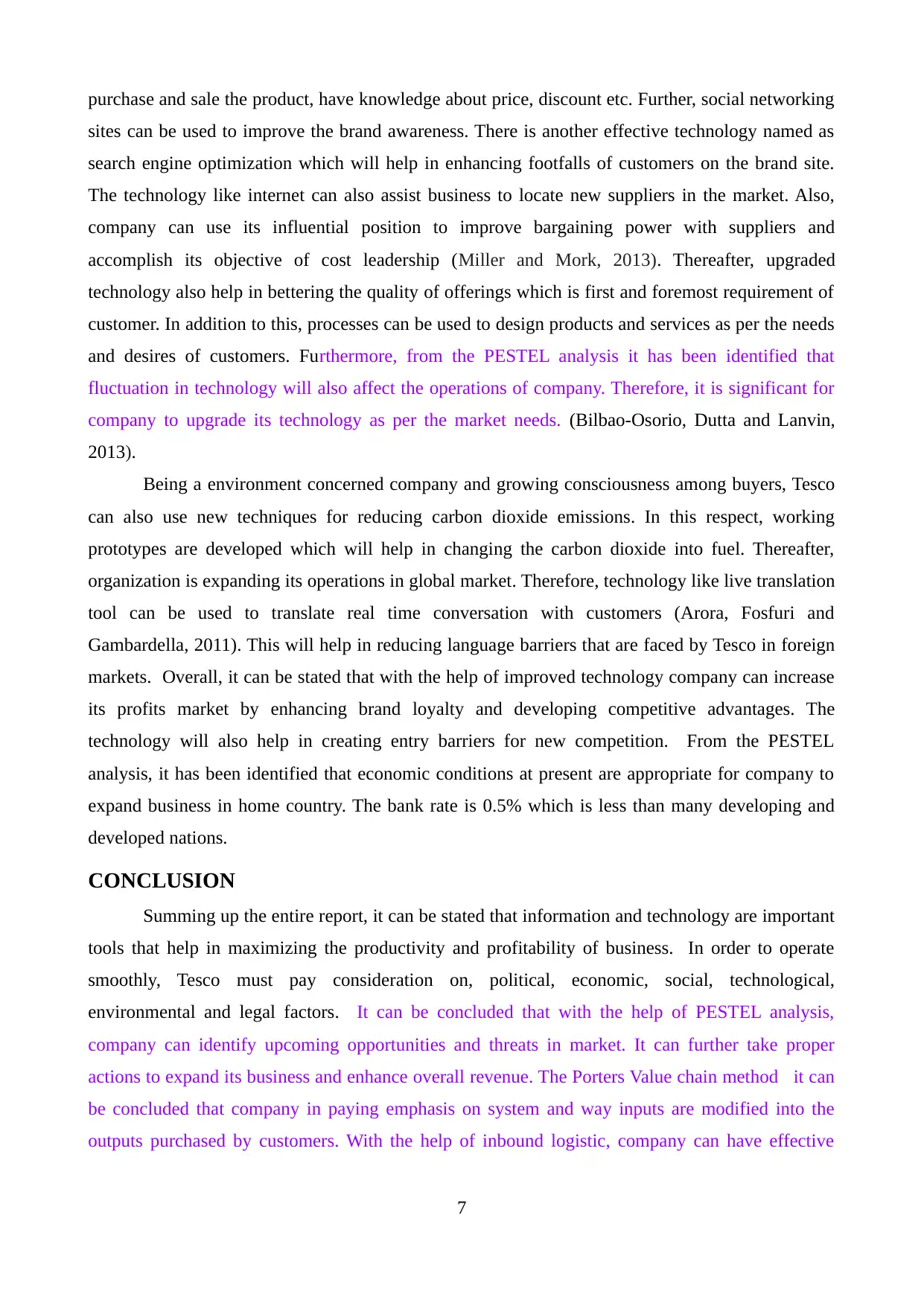
purchase and sale the product, have knowledge about price, discount etc. Further, social networking
sites can be used to improve the brand awareness. There is another effective technology named as
search engine optimization which will help in enhancing footfalls of customers on the brand site.
The technology like internet can also assist business to locate new suppliers in the market. Also,
company can use its influential position to improve bargaining power with suppliers and
accomplish its objective of cost leadership (Miller and Mork, 2013). Thereafter, upgraded
technology also help in bettering the quality of offerings which is first and foremost requirement of
customer. In addition to this, processes can be used to design products and services as per the needs
and desires of customers. Furthermore, from the PESTEL analysis it has been identified that
fluctuation in technology will also affect the operations of company. Therefore, it is significant for
company to upgrade its technology as per the market needs. (Bilbao-Osorio, Dutta and Lanvin,
2013).
Being a environment concerned company and growing consciousness among buyers, Tesco
can also use new techniques for reducing carbon dioxide emissions. In this respect, working
prototypes are developed which will help in changing the carbon dioxide into fuel. Thereafter,
organization is expanding its operations in global market. Therefore, technology like live translation
tool can be used to translate real time conversation with customers (Arora, Fosfuri and
Gambardella, 2011). This will help in reducing language barriers that are faced by Tesco in foreign
markets. Overall, it can be stated that with the help of improved technology company can increase
its profits market by enhancing brand loyalty and developing competitive advantages. The
technology will also help in creating entry barriers for new competition. From the PESTEL
analysis, it has been identified that economic conditions at present are appropriate for company to
expand business in home country. The bank rate is 0.5% which is less than many developing and
developed nations.
CONCLUSION
Summing up the entire report, it can be stated that information and technology are important
tools that help in maximizing the productivity and profitability of business. In order to operate
smoothly, Tesco must pay consideration on, political, economic, social, technological,
environmental and legal factors. It can be concluded that with the help of PESTEL analysis,
company can identify upcoming opportunities and threats in market. It can further take proper
actions to expand its business and enhance overall revenue. The Porters Value chain method it can
be concluded that company in paying emphasis on system and way inputs are modified into the
outputs purchased by customers. With the help of inbound logistic, company can have effective
7
sites can be used to improve the brand awareness. There is another effective technology named as
search engine optimization which will help in enhancing footfalls of customers on the brand site.
The technology like internet can also assist business to locate new suppliers in the market. Also,
company can use its influential position to improve bargaining power with suppliers and
accomplish its objective of cost leadership (Miller and Mork, 2013). Thereafter, upgraded
technology also help in bettering the quality of offerings which is first and foremost requirement of
customer. In addition to this, processes can be used to design products and services as per the needs
and desires of customers. Furthermore, from the PESTEL analysis it has been identified that
fluctuation in technology will also affect the operations of company. Therefore, it is significant for
company to upgrade its technology as per the market needs. (Bilbao-Osorio, Dutta and Lanvin,
2013).
Being a environment concerned company and growing consciousness among buyers, Tesco
can also use new techniques for reducing carbon dioxide emissions. In this respect, working
prototypes are developed which will help in changing the carbon dioxide into fuel. Thereafter,
organization is expanding its operations in global market. Therefore, technology like live translation
tool can be used to translate real time conversation with customers (Arora, Fosfuri and
Gambardella, 2011). This will help in reducing language barriers that are faced by Tesco in foreign
markets. Overall, it can be stated that with the help of improved technology company can increase
its profits market by enhancing brand loyalty and developing competitive advantages. The
technology will also help in creating entry barriers for new competition. From the PESTEL
analysis, it has been identified that economic conditions at present are appropriate for company to
expand business in home country. The bank rate is 0.5% which is less than many developing and
developed nations.
CONCLUSION
Summing up the entire report, it can be stated that information and technology are important
tools that help in maximizing the productivity and profitability of business. In order to operate
smoothly, Tesco must pay consideration on, political, economic, social, technological,
environmental and legal factors. It can be concluded that with the help of PESTEL analysis,
company can identify upcoming opportunities and threats in market. It can further take proper
actions to expand its business and enhance overall revenue. The Porters Value chain method it can
be concluded that company in paying emphasis on system and way inputs are modified into the
outputs purchased by customers. With the help of inbound logistic, company can have effective
7
Paraphrase This Document
Need a fresh take? Get an instant paraphrase of this document with our AI Paraphraser
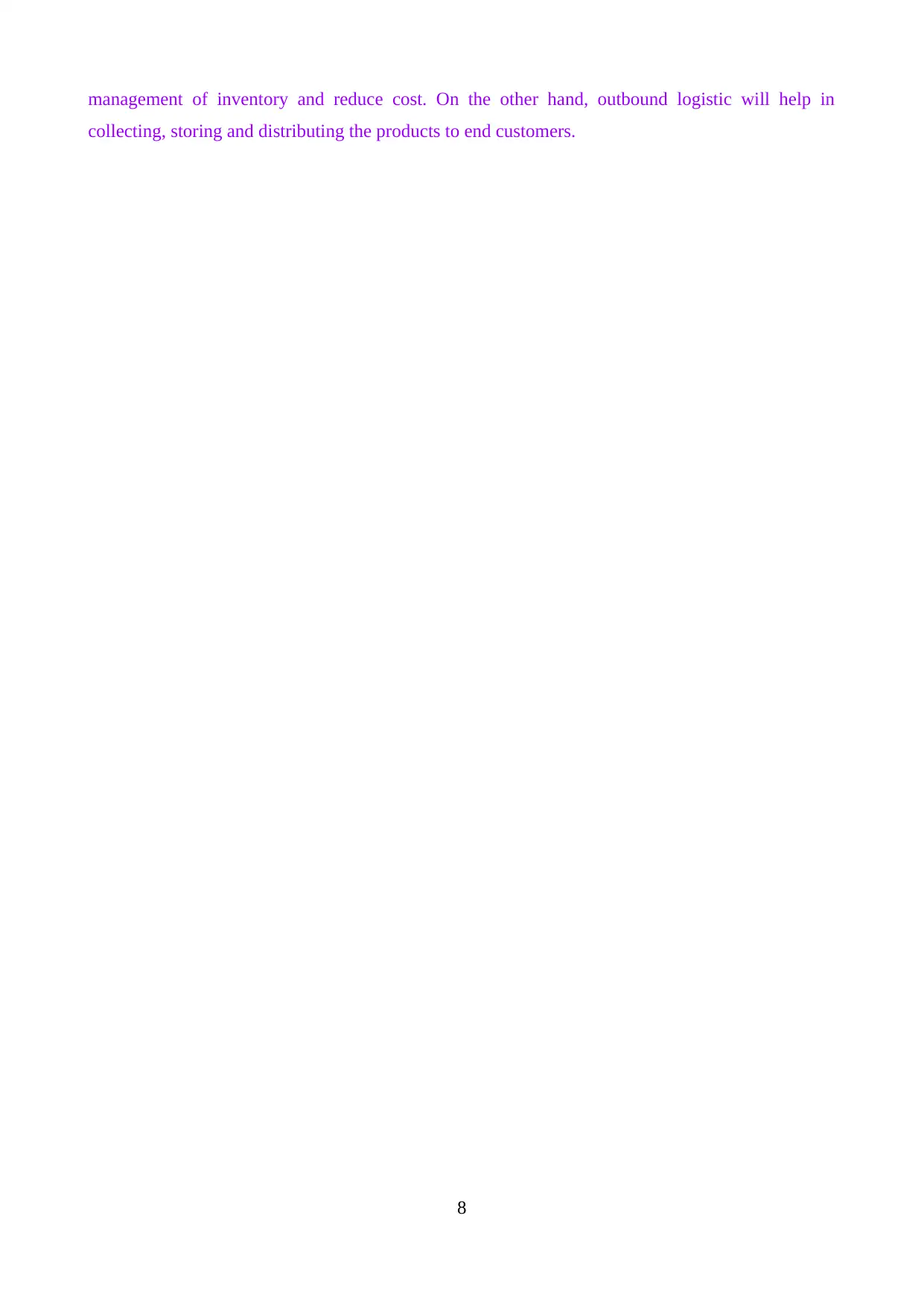
management of inventory and reduce cost. On the other hand, outbound logistic will help in
collecting, storing and distributing the products to end customers.
8
collecting, storing and distributing the products to end customers.
8
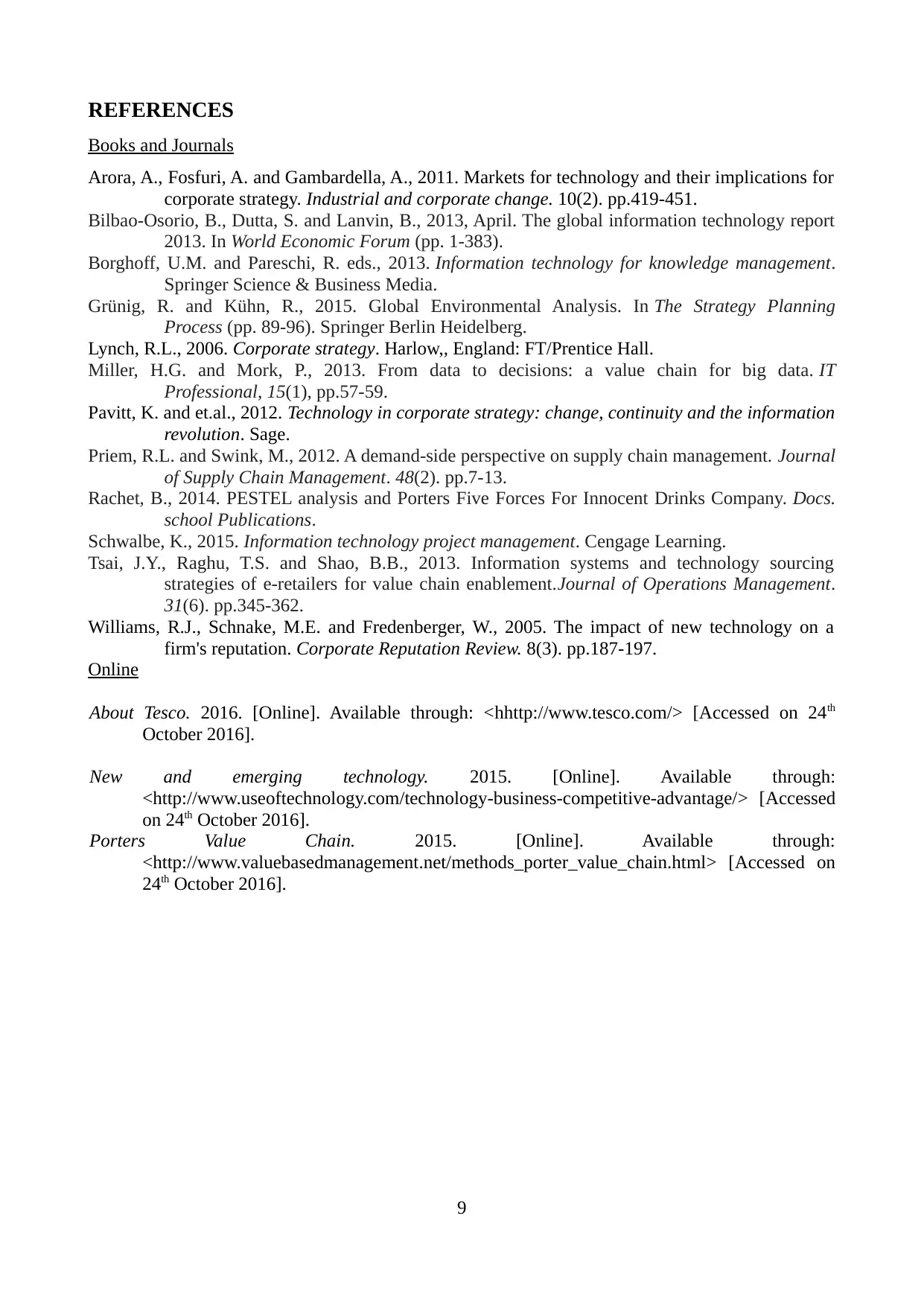
REFERENCES
Books and Journals
Arora, A., Fosfuri, A. and Gambardella, A., 2011. Markets for technology and their implications for
corporate strategy. Industrial and corporate change. 10(2). pp.419-451.
Bilbao-Osorio, B., Dutta, S. and Lanvin, B., 2013, April. The global information technology report
2013. In World Economic Forum (pp. 1-383).
Borghoff, U.M. and Pareschi, R. eds., 2013. Information technology for knowledge management.
Springer Science & Business Media.
Grünig, R. and Kühn, R., 2015. Global Environmental Analysis. In The Strategy Planning
Process (pp. 89-96). Springer Berlin Heidelberg.
Lynch, R.L., 2006. Corporate strategy. Harlow,, England: FT/Prentice Hall.
Miller, H.G. and Mork, P., 2013. From data to decisions: a value chain for big data. IT
Professional, 15(1), pp.57-59.
Pavitt, K. and et.al., 2012. Technology in corporate strategy: change, continuity and the information
revolution. Sage.
Priem, R.L. and Swink, M., 2012. A demand‐side perspective on supply chain management. Journal
of Supply Chain Management. 48(2). pp.7-13.
Rachet, B., 2014. PESTEL analysis and Porters Five Forces For Innocent Drinks Company. Docs.
school Publications.
Schwalbe, K., 2015. Information technology project management. Cengage Learning.
Tsai, J.Y., Raghu, T.S. and Shao, B.B., 2013. Information systems and technology sourcing
strategies of e-retailers for value chain enablement.Journal of Operations Management.
31(6). pp.345-362.
Williams, R.J., Schnake, M.E. and Fredenberger, W., 2005. The impact of new technology on a
firm's reputation. Corporate Reputation Review. 8(3). pp.187-197.
Online
About Tesco. 2016. [Online]. Available through: <hhttp://www.tesco.com/> [Accessed on 24th
October 2016].
New and emerging technology. 2015. [Online]. Available through:
<http://www.useoftechnology.com/technology-business-competitive-advantage/> [Accessed
on 24th October 2016].
Porters Value Chain. 2015. [Online]. Available through:
<http://www.valuebasedmanagement.net/methods_porter_value_chain.html> [Accessed on
24th October 2016].
9
Books and Journals
Arora, A., Fosfuri, A. and Gambardella, A., 2011. Markets for technology and their implications for
corporate strategy. Industrial and corporate change. 10(2). pp.419-451.
Bilbao-Osorio, B., Dutta, S. and Lanvin, B., 2013, April. The global information technology report
2013. In World Economic Forum (pp. 1-383).
Borghoff, U.M. and Pareschi, R. eds., 2013. Information technology for knowledge management.
Springer Science & Business Media.
Grünig, R. and Kühn, R., 2015. Global Environmental Analysis. In The Strategy Planning
Process (pp. 89-96). Springer Berlin Heidelberg.
Lynch, R.L., 2006. Corporate strategy. Harlow,, England: FT/Prentice Hall.
Miller, H.G. and Mork, P., 2013. From data to decisions: a value chain for big data. IT
Professional, 15(1), pp.57-59.
Pavitt, K. and et.al., 2012. Technology in corporate strategy: change, continuity and the information
revolution. Sage.
Priem, R.L. and Swink, M., 2012. A demand‐side perspective on supply chain management. Journal
of Supply Chain Management. 48(2). pp.7-13.
Rachet, B., 2014. PESTEL analysis and Porters Five Forces For Innocent Drinks Company. Docs.
school Publications.
Schwalbe, K., 2015. Information technology project management. Cengage Learning.
Tsai, J.Y., Raghu, T.S. and Shao, B.B., 2013. Information systems and technology sourcing
strategies of e-retailers for value chain enablement.Journal of Operations Management.
31(6). pp.345-362.
Williams, R.J., Schnake, M.E. and Fredenberger, W., 2005. The impact of new technology on a
firm's reputation. Corporate Reputation Review. 8(3). pp.187-197.
Online
About Tesco. 2016. [Online]. Available through: <hhttp://www.tesco.com/> [Accessed on 24th
October 2016].
New and emerging technology. 2015. [Online]. Available through:
<http://www.useoftechnology.com/technology-business-competitive-advantage/> [Accessed
on 24th October 2016].
Porters Value Chain. 2015. [Online]. Available through:
<http://www.valuebasedmanagement.net/methods_porter_value_chain.html> [Accessed on
24th October 2016].
9
⊘ This is a preview!⊘
Do you want full access?
Subscribe today to unlock all pages.

Trusted by 1+ million students worldwide
1 out of 9
Related Documents
Your All-in-One AI-Powered Toolkit for Academic Success.
+13062052269
info@desklib.com
Available 24*7 on WhatsApp / Email
![[object Object]](/_next/static/media/star-bottom.7253800d.svg)
Unlock your academic potential
Copyright © 2020–2025 A2Z Services. All Rights Reserved. Developed and managed by ZUCOL.





